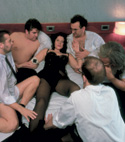As the three curators put it, this exhibition that was opened at the
Neue Galerie in Graz, Austria, between October and December 2002,
intended “to lift a long overdue ban on the Balkans as a site of
intellectual endeavor and cultural desire.” Roger Conover – executive
editor of the department of art, architecture and visual culture at the
famous MIT Press in Boston-, Eda Cufer – an active Slovenian art critic,
promoter of the Irwin group, and Peter Weibel – outstanding Austrian
visual artist and theoretician, conceived In Search of Balkania as a
curatorial operation and an artistic experience “against expectations”,
confronting a subject full of historical contradictions and cultural
prejudices, infamous due to the recent ex-Yugoslavian wars, but also
full of an enormous creative potential. It is this explosive artistic
richness that has become recently fashionable again in Western Europe,
especially in the German-speaking countries, as the great number of
cultural events dedicated to the Balkans in the last two years prove.
After five years of travels and researches throughout the South-East
European cultural milieus, 60 artists have been eventually selected to
construct a “matrix of Balkanic spaces” and a “complex of metaphors” for
what would mean the genius loci and the strange, incongruous, essence of
homo balkanicus. Alongside the two floors of the Neue Galerie in Graz,
an impressive, sophisticated, and sometimes shocking exhibitional
discourse was displayed, that filled up the white, aseptic cubes of
museum logic with an extremely inventive visual production, full of
vivid, unsophisticated, and “hot”, trueness to life, as usually
contemporary cosmopolit museums and art galleries rarely show.
Photography, installation, video and media art dominate the exhibition,
wherein from one room to another one can meet either a phenomenology of
the banal, or a conceptual rememoration of the secret history of the
historical avant-garde (whose artists often originated from this
region), or a situationistic approach of recent history and present-day
politics, or, at last/in fine, a critical-ironical (re)appropriation of
the Western canon of art history. Serbian body-art of the ‘70s and
performance of the ‘80s, Croatian post-conceptualism of the ‘90s,
Romanian neo-dadaism, Slovenian “retro-avant-gardism”, or Bulgarian “desacralism”,
as well as the virulent religious kitsch, an inventive vernacular Gypsy
architecture, the rich urban folklore, the post-communist architecture
of power, or local “neo-byzantinism” – these are aspects that this
exhibition takes into account to prove that the Balkans are an
inexhaustible although not yet “sublimized” source of culture without
which the future of Europe is
unimaginable.
|
One must mention here the strong presence of artists such as the Serbian
Marina Abramovic, the Turk Huseyin Alptekin, the Bulgarians Nedko
Solakov and Luchezar Bojadijev, the Croat Sanja Ivekovic, the Romanian
group subREAL, the Albanian Adrian Paci, the Slovenian group Irwin,
whose names are already vehiculated/conveyed in the international
environment. One could add also some less-known names such as Teodor
Graur, Andrei Ujica, the female group Eclipse, Zoran Naskovski, Vlasta
Delimar, Kiril Prashkov, Ivana Keser, Vlado Martek, Braco Dmitrijevic,
Tanja Ostojic, Anri Sala, Rasa Todosijevic, that would deserve more
attention. Between the ethnographical temptation, due to the picturesque
“otherness” that this region still preserves in the mind of many
Westerners, on one side, and the temptation of an internationalized
visual jargon, induced by any “mega show” intended to recuperate and
integrate a subject on the planetary cultural market, on the other side,
the three curators have succeeded to keep a good balance. The artists’
works focus mainly on the recent totalitarian past or the confuse,
insecure, “transitional” present, on aggressive nationalism and obsolete
parochialism, on economic and political misery, and last but not least
on pro- and anti-Western clicheés. But what emerges from the sometimes
cynical, sometimes humorous, sometimes tragic mixtures of all kinds of
local artifacts and national symbols with sophisticated Western visual
technologies is mainly an extraordinary vitality and creativity.
Colorful, overwhelming, full of sarcastic sincerity about human nature
and history, this vital creativity assumes and features courageously an
enormous esthetic and existential Kitsch.
It is difficult to say whether this kitsch, “crude” and also pathetic as
it is, pertains more to the artists than to the curators. Anyway, it
speaks convincingly about “a virtual encounter with the future” of the
Western world, as the curators put it, insofar by the actual
peripheralizing of the West brought about by the global mixing of
cultures and the superposition of contradictory visual traditions “there
is nothing in store for Europe and the West but the Balkans”. In this
respect, by its hybrid, “impure” nature, modeled by various conflicting
cultural and spiritual traditions, the soft and democratic concept of
visual Balkanism, rather than the dangerous political concept of
Balkanism, might become an interesting aesthetic methodology, well
adapted to the “less-stable” cultural syntheses and the “diasporic”
reality of the present-day planetary destabilized melting-pot. In a
world where stable, monolithic cultures tend to become exceptions,
between the Scyla of monotonous globalization and the Carybda of local
cultural sufficiency, visual (and spiritual) Balkanism might represent a
possible model for fruitful reflections.
Magda Carneci
|

